“I desire a monarch for our state; but I desire one worthy of the honor which he would receive in commanding us; that is to say, I wish a greater man than Prince John of Portugal ; and I wish a monarch who would rule us only.”
– Juan Martín de Pueyrredón, Supreme Director, in a letter to José de San Martín, March 3, 1817
I have been remiss once again in continuing to post my little walks around the city. My goal this year, along with whatever else may come, is to continue this little jaunt through the streets named in homage to the various leaders of this republic, and see where it might take me. So on to our 6th Supreme Director, Juan Martín de Pueyrredón, son of a French Basque family that settled in the country in the mid to late 1700s, he was born December 18, 1776 in Buenos Aires, grew up with expectations of a short military career to be followed by assuming his father’s place in the business world. That ideal was cut short in 1791 when his father passed away and Juan Martín left the Royal College and his education behind to take on the family business. I have to gather that things didn’t go well, as in four short years he left Buenos Aires behind and spent much of the next decade traveling about in Spain and France.
At some point he returned, but fled BA when the British occupied it in 1806, heading out into the countryside, where he became involved in the independence movement and returned quickly to his plans of a military career. He quickly rose through the ranks and became one of the key players, both as a quasi-ambassador to Brazil and as a military leader. By 1810, following the May Revolution, he was appointed governor of the Córdoba province, in 1812 was one of the members of the short-lived First Triumvarate post-war council, and was then sent into exile, in part by his former friend and mentor, José de San Martín, for being a royalist rather than an true advocate of independence, during the ensuing years, until returning in 1816 and being appointed to the position of Supreme Director. He served in that position longer than any of the others who occupied the office, from July 9, 1816 to June 9, 1819, nearly three years, was founder of the first national bank in the country, as well as the mint. He resigned after the declaration of a Unitarian constitution, still holding fast to his beliefs that a monarchy was in Argentina’s best interests (and some say, operated out of his position in much that way):
“I did no more than to respond to the dark measures of the directory of Buenos Aires and to the war which it made upon me because it considered that I was an enemy of centralization. . . . Taking the United States as a model, I desired the autonomy of the Platean provinces, granting to each state its own government, its constitution and its flag, with the right to elect its representatives, its judges, and its governors from its own natural-born citizens. This is what I attempted to do for my province and for those other provinces which proclaimed me their Protector. . . . But the Pueyrredons and their assistants wished to make of Buenos Aires a new imperial Rome which could send its proconsuls to govern the provinces in a military fashion and deprive them of all political representation, just as it rejected the deputies whom the people of la Banda Oriental selected for the constituent assembly, and as it set a price upon my head.”
– José Gervasio Artigas, father of Uruguayan independence
Pueyrredón went into exile in Montevideo for a few years, and when he later returned, played little part in local politics, instead spending his time at his home in San Isidro (where the house still stands, near to the main square, and houses a museum). He had married and had a son during his tenure as supreme director, Prilidiano, who became quite a famous painter. He died at home, March 13, 1850. The street named after him, Avenida Juan Martín de Pueyrredón, is primarily a commercial thoroughfare that stretches from Avenida Libertador to its termination at Avenida Rivadavia (where it changes names to Avenida Jujuy). And, away we go….
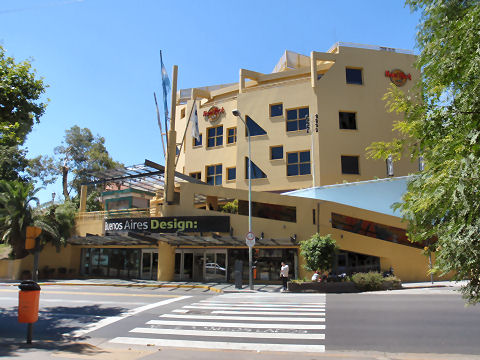
Though technically, the far end of Pueyrredón is at Av. Alcorta, around the 2600 mark, that last block between Alcorta and Libertador is little more than traffic islands. The Fine Arts Museum is off to one side, but not on this avenue, so I leave it aside. The first building one truly encounters is at 2501, the Buenos Aires Design Center, a shopping mall for all things home related, be they furniture, door locks, bathroom fixtures, or artwork for the walls. Also home to several restaurants that include Hard Rock Cafe, a branch of Tucson, Go Sushi and Primafila.
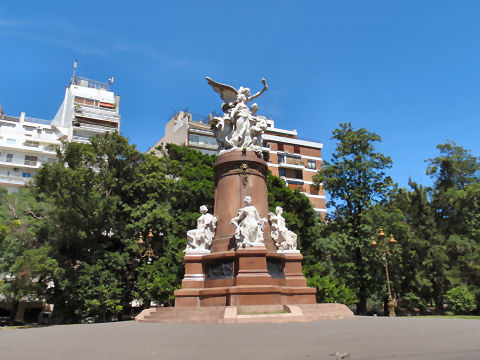
Opposite the mall is Plaza Francia with its monument to the people of Argentina from the people of France. It’s a pretty little plaza with beautiful trees.
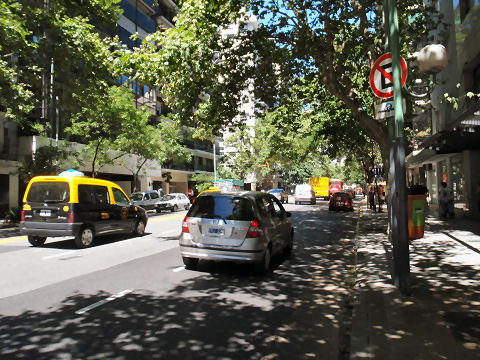
As mentioned above, this is a busy thoroughfare, and one of the few main avenues that is bi-directional.
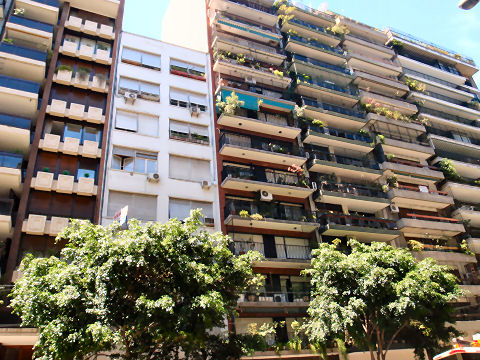
Much of what is in this stretch of the avenue is one apartment building after another, most with few redeeming architectural features.
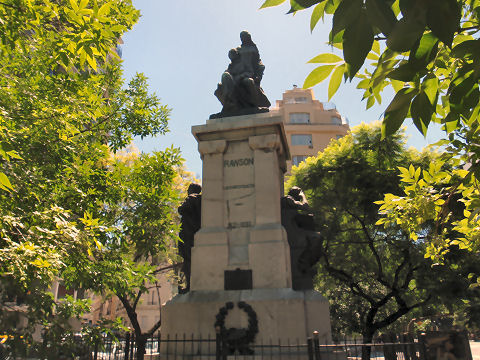
A few short blocks on at Av. Las Heras is a small plaza with a monument to Guillermo Rawson, a doctor and influential politician from the mid 19th century. The statue is a bronze created by Héctor Rocha, an early 20th century sculptor who created many of the famous monuments in Buenos Aires. The marble base has the figures of Reason and Science.
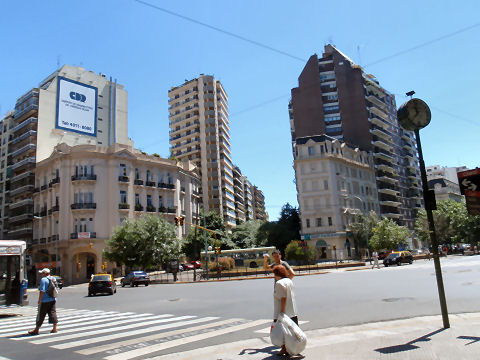
Here to, more easily viewed from cross-corner, is the steep incline that enters what is referred to as La Isla, the Island, a somewhat wealthy enclave of apartment dwellers who surround the British Embassy, perched atop the hill. Along one of these narrow streets is one of my favorite lunch spots, Florencio.
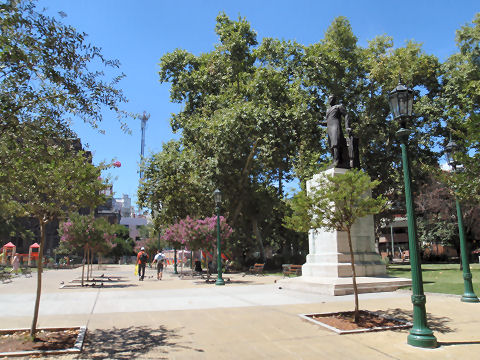
On the far side of Av. Las Heras is the pretty Plaza Emilio Mitre, in honor of the Lieutenant General who was brother to former Argentine president Bartolome Mitre (mid 1800s) and one of the major players in the Argentine civil wars that rocked the period between the Supreme Directors and the later Presidents.
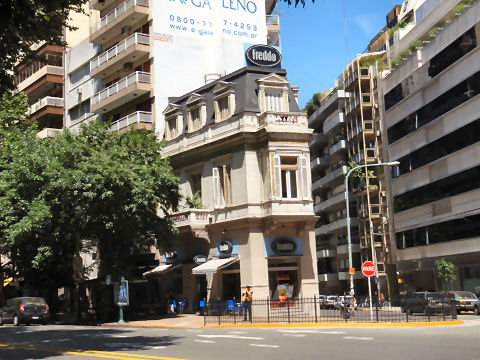
Several blocks further on, Pueyrredón 1894, where Anchorena and Peña join with the avenue, is a pretty little building on a thin triangle of land, now occupied by a branch of the gelato chain, Freddo. I was not able to find any information about what the building might have been. Readers?
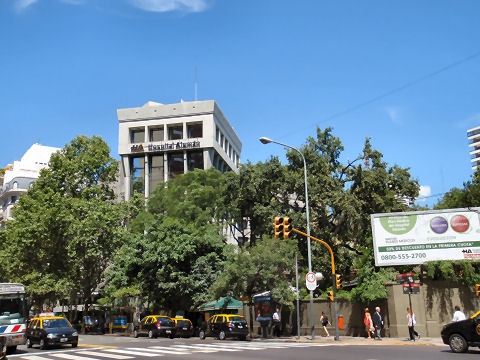
At 1640 is the well-known Hospital Aleman, or German Hospital, which opened August 26, 1867. It has obviously been renovated over time.
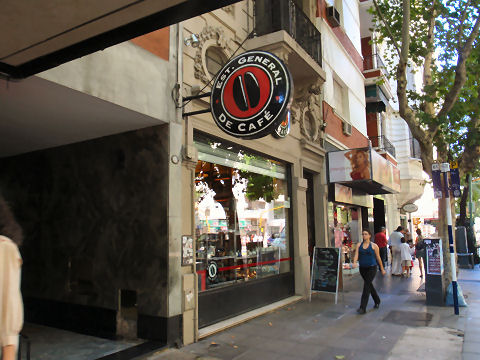
Across the street from the hospital is the main shop of the Est. General de Café, as far as I’m concerned, the only group of coffee shops to buy your beans at in town. They direct import coffee from 20-30 different countries, depending on what’s available, roast daily, grind, and even blend, to order. And, they’re great folk to boot. They have several branches in the city, but this is the spot where they do the roasting.
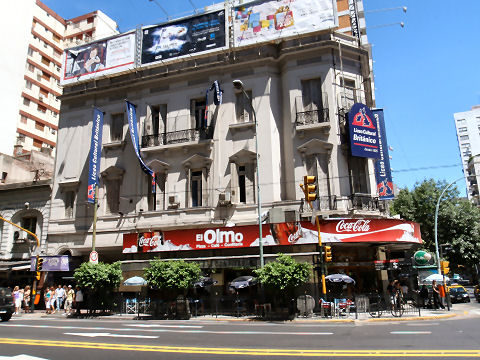
Continuing another block to the corner of Av. Santa Fé we find various locales, such as the only branch of Staples in the country, the main clinics of Swiss Medical, and, on one corner, El Olmo, a pretty much round the clock cafe that, in the evenings, doubles as one of the prime puentos de encuentro, or gathering spots, for the gay community, before heading out to the local bar or club.
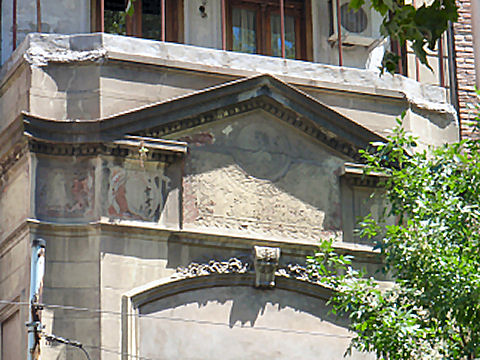
A small building at 1224, notable only for the relief fresco above the door. Again, no information found….
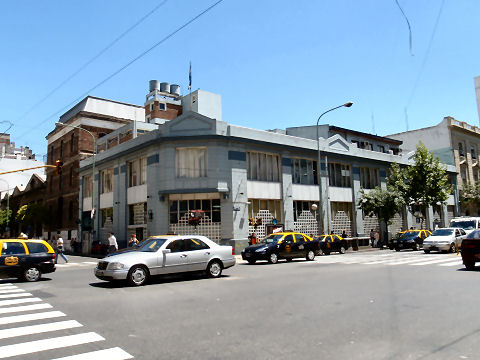
The next few blocks are series of various shops, there is little of note at first glance – I’m sure that one could delve in-depth into the history of some of the buildings. As one enters the barrio Balvanera, more commonly known as Once, several kosher restaurants are to be found, and the presence of the orthodox Jewish community is certainly more noticeable. This building at the corner of Lavalle, only catches the eye because it is so out of place – as far as I’m concerned, ugly doesn’t begin to describe it. I gather it holds the offices of something to do with the federal prison administration. Fitting.
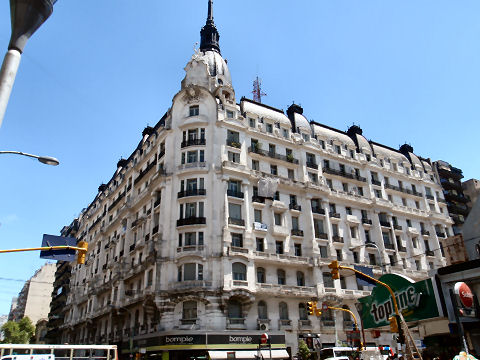
Towards the end of our walk there are several interesting buildings. At #81 is this imposing edifice, taking up roughly ¼ of a city block, and, I gather, a mix of apartments and offices.
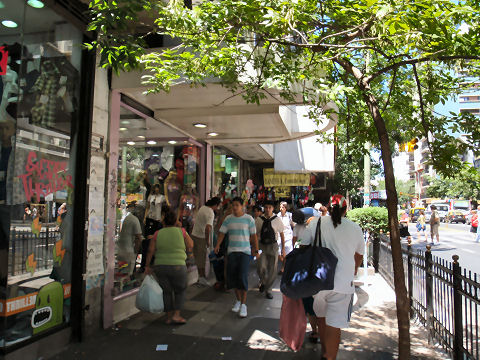
The streets become more crowded, this is discount shopping heaven, or hell, depending on your viewpoint.
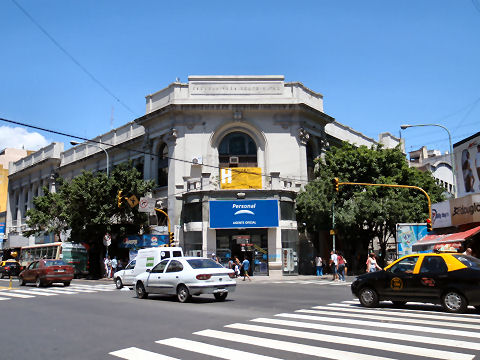
The former Escuela Presidente Mitre at the corner of Sarmiento has been taken over by various commercial enterprises. Take a look here to see how it looked many years ago.
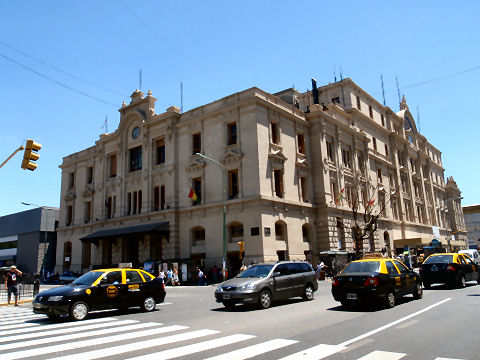
The Estacion Once, home of the original Ferro Carril del Oeste, or Western Train Line, is now a somewhat squalid affair, but still the departure point for all trains headed west.
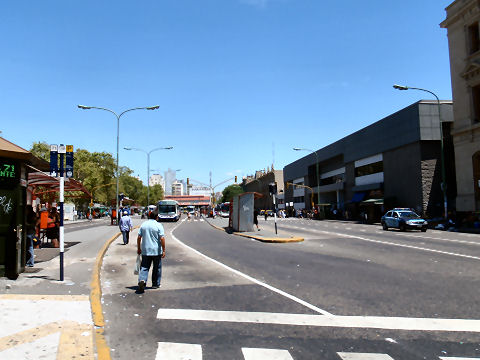
Outside of the train station is one of the primary outdoor terminals for the city’s bus lines.
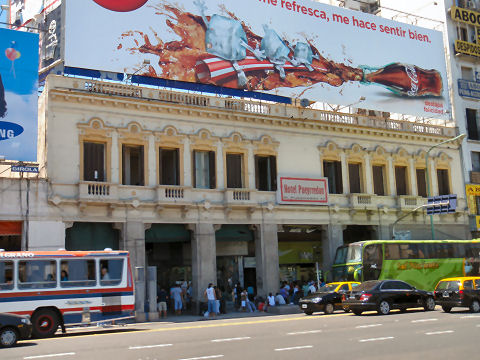
Opposite the station is the Hotel Pueyrredón at #47. It’s a rather attractive building, or once was, though I don’t think I’d want to be lodging in this particular location. The hotel has been on this spot for more than 50 years and is primarily a spot for transients coming in from the north and west and awaiting a train or bus to elsewhere.
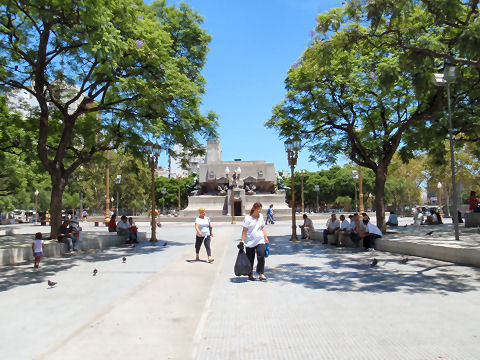
In front of the station, and the endpoint of our walk, bordered on its other side by Av. Rivadavia, is the Plaza Miserere. Only a couple of years ago this was a decrepit, dangerous plaza, with little vegetation and not much to offer other than a few dilapidated statues. It was recently renovated, replanted, refurbished, and just generally “re”. Temporarily, the statues are gone, as they, too, are being refurbished.
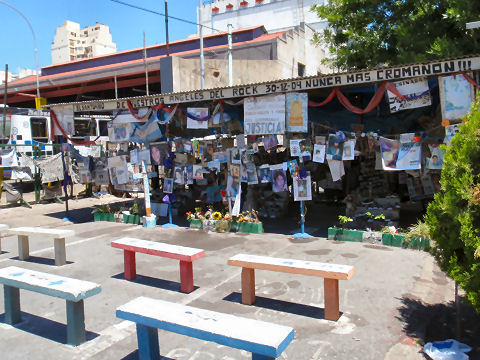
It is worth, at this juncture, a one block side trip to the far side of the plaza, where in a corner at the back of the train station is the memorial to the people who lost their lives in the República Cromañón club fire in 2004. 194 people died and 714 were injured when the fire broke out from flares that fans lit during a concert in the club, a building licensed for 1,000 people in which more than 3,000 had been jammed in and couldn’t escape when it caught on fire. Only recently has any form of justice prevailed with the club owner, band manager, and several city officials who had been bribed to look the other way, having been jailed after a lengthy trial.
When I first read the title, I thought I was going to read about Diana Ross in Argentina or something like that. LOL! 😉
I enjoy these photos of B.A. and the narrations very much.
Paz
What fun to look at the neighborhood and beyond this way. What a great job you did , photographing the buildings ! How did you keep all the cars out of the way ? : )
And thanks to you, we finally drink really good coffee at home, since we started going to EST..
chau ! C
[…] the corner of Av. Pueyrredón we find Plaza Miserere – more info here at the bottom of the post on my walk along that avenue. Since no doubt these ten blocks have made […]
[…] up pen and paper, scribing various anti-royalist sentiments that, in 1816, under the government of Pueyrredón, got him kicked out of the country into exile. He made his way to Baltimore and spent a couple of […]
[…] up as high as 1,432, that may depend on what exactly was considered an injury) in the devastating República Cromañon fire in late 2004 – a fire that many blame on the government at the time, as well as the club owners, and for […]
[…] the plaza onto Rivadavia is a monument to Juan Martín de Pueyrredón, one of the earliest leaders of this […]